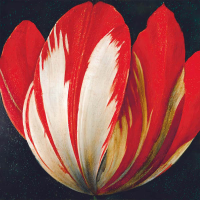57. TIM MAGUIRE

Tim Maguires intense and highly disciplined explorations into the practice of painting include the artists colour separation series which echoes digital printing techniques, and the trompe loeil effects of his Slit paintings inspired by the slash paintings of noted Italian artist Lucio Fontana. While Fontana transformed two dimensions into three by physically cutting openings into the canvas, Maguire accomplished the opposite effect by echoing Fontanas hand-cut holes solely through the use of paint.
Maguires imposing flower paintings, of which this is an impressive example, share similar painterly concerns and revel in the paradoxical nature of compressing three dimensions into a two dimensional art form.
As with Maguires other paintings, the tulip depicted in 98U90 has a monolithic quality resulting from the artists having taken a fragile natural object and depicted it on an unusually large scale. In his heavily cropped and resized flower paintings Maguire takes us into the realm of the spectacle, providing what Adrian Searle has characterised as hypervivid fragments and cinematic close-ups.1
The artists engagement with this subject matter began in 1989, when the birth of his son prompted him to dwell on the theme of mortality.2 This in turn inspired Maguires protracted investigations into the Vanitas tradition of painting, in which devices such as skulls, withered leaves and rotten fruit are commonly juxtaposed with sumptuous blooms and other riches in an effort to remind the viewer of the futile and evanescent nature of human existence.
While Vanitas paintings introduce motifs of decomposition or decay into arrangements of skilfully rendered fruit, flowers and vegetables to create an allegorical statement about mortality, Maguire embraces this theme by distressing his meticulously rendered painted surfaces through the use of solvents. In this series, the artist captures an isolated moment of perfection which endures far beyond the lifespan of the original flower. However, rather than being content to preserve that moment in the aspic of oil paint as he describes it,3 Maguire introduces imperfections in the form of blemishes in the painted surface.
Although the earlier works in Maguires flower series were based on scanned reproductions of seventeenth century Dutch and Flemish paintings, with the advent of digital photography the artist has since embraced that medium. However, Maguire steers away from an overly reverential attitude to his source material, preferring to use it as a springboard for his artistic explorations rather than as a monolithic reference point. Maguires artistic investigations are dictated by the painterly process rather than by the seventeenth century originals in an engagement which he has described as follows:
I was attempting to strip away the preserving wrapper to revivify them, substituting the scrupulously rendered representation of the original with the animation of scale, gesture and fluid paint.4
Although Maguire has described the process of creating the earlier works as one of finding my own paintings within somebody elses,5 in both these and later paintings he revels in putting his source material through what he terms the wash cycle6. This process involves cropping the images and enlarging them to unnaturally large dimensions before animating the flat surfaces inherent in the printed or digitally photographed originals through the use of solvents. In doing so, Maguire creates a tension between the generic or decontextualized images which are his starting point and the unique works of art which result from his artistic interventions. This is further echoed by the anonymity of the titles of Maguires paintings which more closely resemble a cameras date stamp, a serial number or a file name than an evocation of an art works inherent uniqueness.
Maguires complex and incredibly disciplined investigations of the painting process, which de-contextualise and reanimate source material ranging from elements of art history to digital imagery, are very contemporary, yet at the same time grounded in tradition. This is not just the tradition of the Vanitas paintings, but also of the artists perennial grappling with the potential and limitations of paint and with the conundrum of how we see the world versus how we can depict it on canvas.
Footnotes
1. Adrian Searle in Eloise Lindsay & Adrian Searle, Tim Maguire, Met & Chandon, pernay, 1994, p.
2. Laura Murray Cree, Tim Maguire, Piper Press, Annandale NSW, 2007, pp. 74-75.
3. Tim Maguire: Time & Nature, Martin Browne Contemporary, Paddington NSW, 2012, p.1.
4. Ibid.
5. Cree, p. 131.
6. Ibid., p. 74.
Anne Phillips BA (Hons), MA